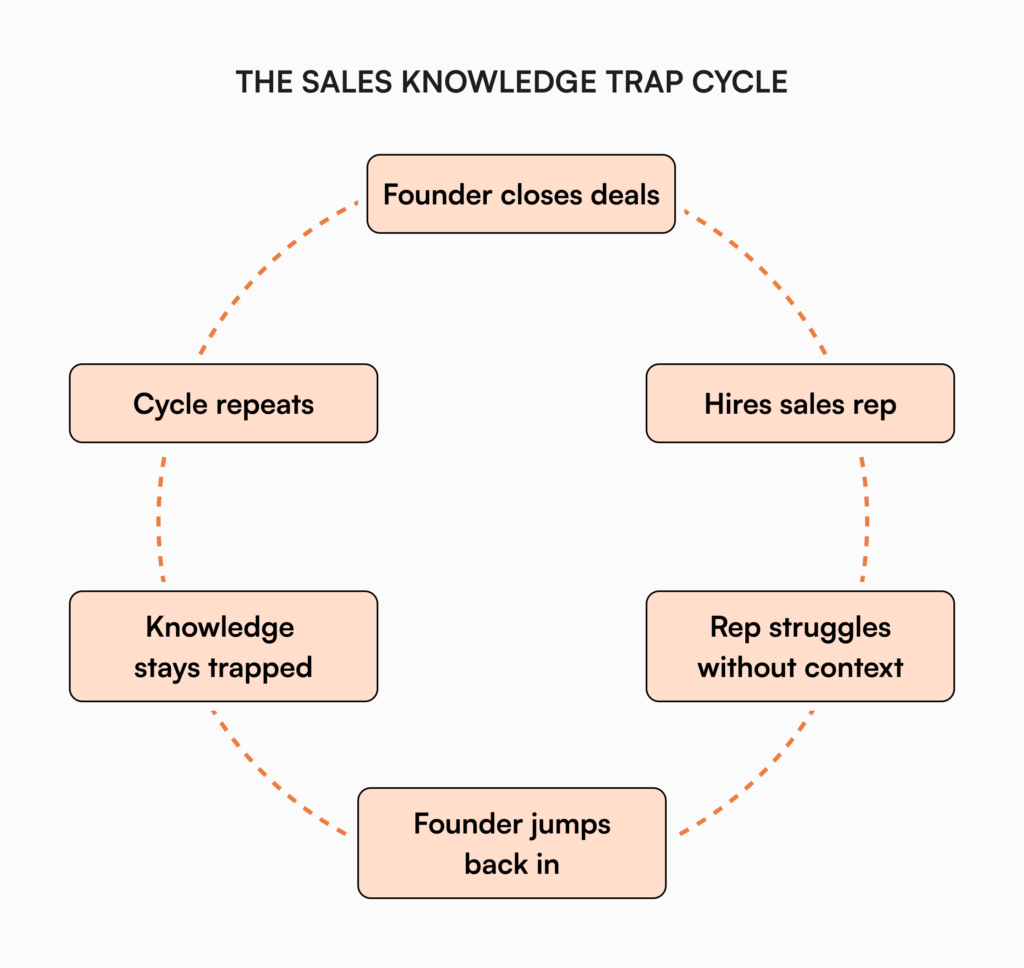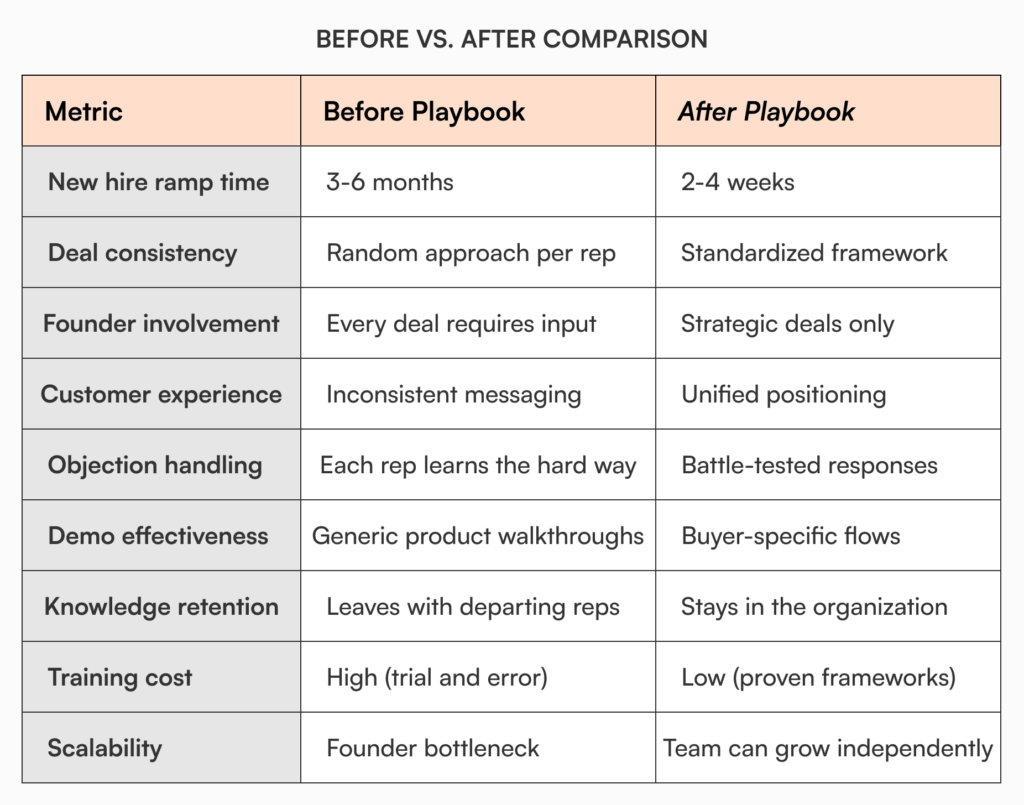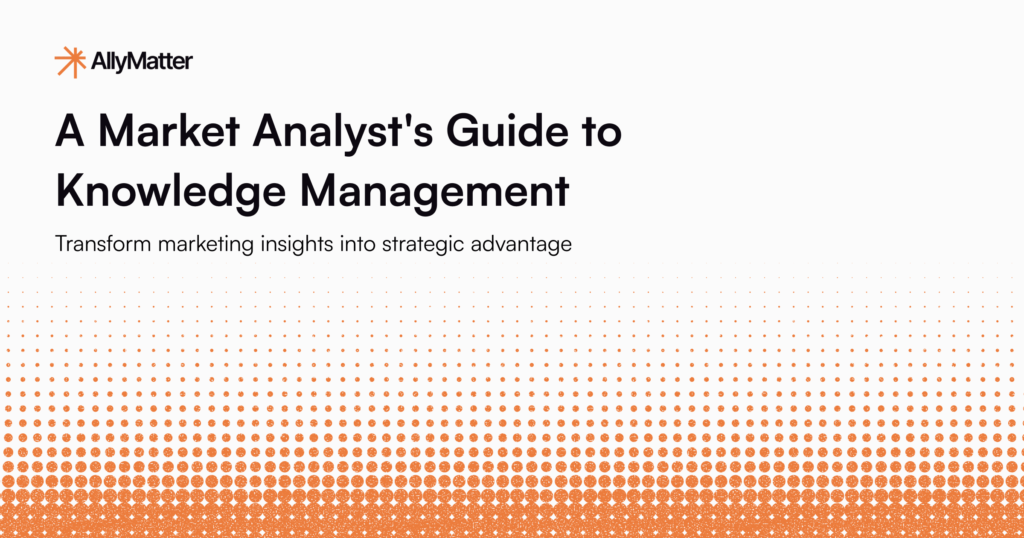You just closed another deal. The euphoria lasts about thirty seconds before reality hits: your new sales hire starts Monday, and they’re going to ask how you did it.
How do you explain the intuition that told you to pivot the demo halfway through? The mental map of objections and responses you’ve built over fifty conversations? That pricing flexibility framework that exists only in your head? You know it works – the signed contracts prove it – but translating founder sales magic into a repeatable process feels impossible.
Here’s the truth: founder-led sales doesn’t scale not because others can’t sell your product, but because the playbook that got you from zero to twenty customers lives entirely in your brain. Every deal is a jazz improvisation only you can perform. Meanwhile, your sales hire is stuck playing chopsticks, and your growth stalls while you remain the bottleneck.
Why founder sales knowledge stays trapped
The challenge isn’t that founders are bad at sales – often, they’re naturals. The challenge is that natural sellers rarely document what they do. Here’s why this knowledge stays locked up:
The curse of unconscious competence: You’ve internalized so much about your market, product, and customers that you don’t realize what you know. When a prospect mentions they’re “evaluating options,” you instinctively know whether that means they’re price shopping or stakeholder building. But you can’t teach instinct.
The “every deal is different” myth: Yes, every customer is unique. But after twenty deals, patterns emerge. You’re probably running variations of the same three conversations, handling the same five objections, and navigating the same two or three buying processes. You just haven’t noticed the patterns because you’re too deep in each individual deal.
The fear of constraining creativity: Many founders worry that documenting their sales process will turn it into a rigid script. They’ve seen corporate sales playbooks that drain humanity from selling, and they want no part of it. So they document nothing, ensuring no one else can sell with their effectiveness.
The moving target problem: Your product evolves weekly. Your ideal customer profile shifts as you learn. Your pricing model changes based on market feedback. How can you document a process that won’t be accurate next month? This perfectionism keeps you from capturing what’s working right now.

The hidden cost of hoarding sales knowledge
When sales knowledge stays trapped in the founder’s head, growth hits a ceiling:
The hire-and-hope cycle: You hire experienced salespeople, assuming their past success will translate. Without your market knowledge and battle-tested approaches, they flounder. Three months later, they’re gone, and you’re back to closing every deal yourself.
The inconsistent customer experience: When you finally do scale the team, every rep invents their own approach. Customers get wildly different experiences depending on who they talk to. Your carefully crafted positioning gets diluted into whatever each rep thinks sounds good.
The founder bottleneck: Every deal needs your involvement because you’re the only one who knows how to handle that tricky question about roadmap timing or that specific competitor comparison. You become the bottleneck you hired salespeople to eliminate.
The lost learning loop: Every lost deal teaches you something, but those lessons stay with you. Your team keeps making the same mistakes because the collective learning isn’t captured anywhere. Each rep has to personally discover that enterprise buyers always want SOC 2 compliance – usually by losing a deal.
The five components of a living sales playbook
You don’t need a 100-page sales manual. Start with these five living documents that capture your sales DNA:
1. The customer journey map
Document the real path your successful customers take:
- How they first discover their problem (what triggers the search?)
- Where they look for solutions (communities, review sites, Google?)
- Who gets involved in the decision (user vs. buyer vs. influencer)
- What concerns arise at each stage
- How long each phase typically takes
Include real examples: “StartupCo discovered us through a ProductHunt launch, had their CTO evaluate for two weeks, then brought in the CFO for pricing discussions. Total cycle: 22 days.”
2. The discovery question bank
Your best discovery questions are gold. Document:
- Opening questions that get prospects talking
- Follow-up probes that uncover real pain
- Questions that reveal budget and timeline
- Ways to identify the real decision maker
But don’t just list questions. Explain why each matters: “When they mention ‘scaling challenges,’ dig deeper with ‘Walk me through what happened the last time you hit a scaling issue.’ This usually reveals whether they need our automation features or just more seats.”
3. The objection response guide
Every founder has battle-tested responses to common objections. Capture them:
- The objection (in the customer’s actual words)
- What it really means (the underlying concern)
- Your response framework (not a script)
- Proof points that support your response
Example: “Objection: ‘You’re too expensive for our stage.’ Really means: ‘I haven’t connected the price to ROI.’ Response: Shift from cost to return – ‘Let’s map out what five hours saved per week means for your team…'”
4. The demo flow that converts
Your demo isn’t random. Document:
- Pre-demo discovery (what you must know before showing anything)
- The “Wow” moment you build toward
- Features to show vs. skip for different buyer types
- Common questions and smooth transitions
- The bridge from demo to next steps
Include your read-the-room insights: “If they start asking about integrations early, they’re usually technical buyers who’ve been burned by incomplete products. Shift to architecture discussion.”
5. The pricing conversation framework
Pricing discussions make or break deals. Share your approach:
- When to introduce pricing in the process
- How to frame value before revealing price
- Flexible levers (payment terms, contract length, feature bundles)
- Common negotiation patterns and responses
- When to hold firm vs. accommodate
Real talk: “Start-ups always ask for discounts. Instead of reducing price, I offer extended payment terms or success-based milestones. Preserves our value while addressing cash flow concerns.”
Making your playbook actually living
Static playbooks die quickly. Here’s how to build one that evolves with your learning:
Start with your next deal: Don’t document retrospectively. On your next sales call, take five minutes afterward to capture what happened. What questions worked? What objection surprised you? Build your playbook one real interaction at a time.
Record and transcribe: Use call recording tools to capture your actual sales conversations. Transcribe them and pull out the golden moments – that perfect explanation of your differentiator, that smooth objection handle. Real words beat theoretical scripts.
The weekly pattern review: Every Friday, spend 30 minutes reviewing the week’s deals. What patterns emerged? What new competitor came up? What pricing pushback did you hear? Add these insights to your playbook immediately.
Version your victories: When something works brilliantly, document it with context. “Used the ROI calculator approach with FinanceApp – moved them from ‘too expensive’ to signed contract in one call. Key was starting with their current tool costs, not our pricing.”
From Founder instinct to team capability
Here’s how to transfer your sales knowledge without losing what makes it effective:
Shadow sessions: Have new reps shadow your calls, but give them observation assignments. “Listen for how I transition from discovery to demo.” Afterward, debrief what they noticed. This teaches pattern recognition, not mimicry.
Role play real scenarios: Use actual situations from your playbook. “You’re talking to a technical founder who loves the product but says they need board approval.” Let reps practice with your frameworks, then share what actually worked in that situation.
The graduated handoff: Don’t go from founder-led to rep-led overnight. Start by having reps handle specific portions – maybe discovery calls or follow-ups. Gradually expand their ownership as they prove they’ve internalized your approaches.
Feedback loops that work: Create a simple way for reps to flag what’s not working. Maybe your enterprise positioning needs updating, or a new competitor requires fresh battle cards. Make playbook evolution everyone’s responsibility.
The tools and systems that scale
Your sales playbook needs to be accessible and actionable:
Central source of truth: Whether it’s Notion, Google Docs, or a dedicated tool, pick one place for all sales knowledge. No scattered documents or outdated versions. Everyone should know exactly where to find the latest approaches.
Quick reference formats: Create cheat sheets for common situations:
- Discovery call checklist
- Demo environment setup
- Objection quick responses
- Pricing guidelines summary
Search and find: Tag and organize content so reps can quickly find answers during calls. “Competitor: AcmeCorp” should instantly surface your positioning against them.
When it’s time for real sales enablement
As you scale beyond a handful of reps, managing sales knowledge gets complex. You’ll need to track which approaches actually work, ensure everyone’s using the latest talk tracks, and maintain consistency while allowing for individual style.
This is where tools like AllyMatter transform sales enablement. Your playbook becomes truly living with version control that shows how your approach evolves. New competitive intelligence or pricing updates flow automatically to the team. Reps acknowledge they’ve reviewed critical updates. Analytics show which resources actually get used versus gathering digital dust.
The transformation from founder-led to team-based selling doesn’t happen overnight, but it starts with capturing what you know in a way others can learn and apply.
The compound effect of documentation
Here’s what happens when you nail your sales playbook:
Ramp time plummets: New reps contribute in weeks, not months. They’re learning from your accumulated wisdom, not starting from scratch.
Consistency at scale: Every prospect gets your best positioning, regardless of who they talk to. Your win rate improves because proven approaches get used consistently.
Collective learning: The team’s discoveries enhance the playbook. Your rep in Seattle figures out how to sell to healthcare? Everyone benefits immediately.
Founder freedom: You shift from chief salesperson to strategic advisor. Jump into deals that need you, not every deal that exists.

Your first three steps
Building a living sales playbook doesn’t require a sabbatical. Start here:
This week: After your next three sales calls, spend 10 minutes documenting what happened. What worked? What questions came up? What would you tell someone handling this exact situation?
Next week: Pick your most common objection. Write down your actual response – not what you think you say, but what you really say when it works. Share it with anyone else who sells.
This month: Record one great sales call. Transcribe it. Pull out three moments of brilliance. Those become the foundation of your demo guide, discovery framework, or objection handling.
Remember: Your sales success isn’t accidental. You’ve developed approaches that work. The magic isn’t in keeping them secret – it’s in helping others apply them with the same conviction you do.
Ready to transform your sales knowledge into a scalable system? Join our waitlist.
Frequently asked questions
How do I document sales processes without losing the personal touch?
Start with frameworks, not scripts. Capture your decision-making process and the “why” behind your approaches. Document the principles and flexible responses rather than word-for-word scripts that sound robotic.
What if my sales process keeps changing as we learn about our market?
That’s exactly why you need a living playbook. Document your current best practices, then update them as you learn. Version control helps track what’s working versus what you’ve moved on from.
How long should it take a new sales hire to become productive with a documented playbook?
With a well-structured playbook, new sales team members should contribute meaningfully within 2-4 weeks instead of 2-4 months. The key is having frameworks they can practice with, not just information to memorize.
Should I document every possible sales scenario?
Focus on the patterns that repeat in 80% of your deals. Document your most common objections, buyer types, and demo flows. Edge cases can be handled on an as-needed basis once the fundamentals are solid.
How do I get my sales team to actually use the playbook instead of winging it?
Make it easily accessible and immediately useful. If finding an objection response takes longer than remembering it, no one will use the system. Also, show results – track how documented approaches perform versus improvised ones.


